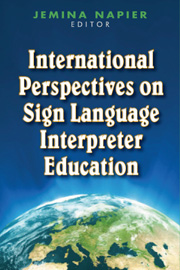Jemina Napier, Editor
|
View the table of contents. View the list of contributors. Read an excerpt. Read a review. |
$75.00s print edition $75.00 e-book |
Interpreter Education, Volume 4
From Interpreting, International Journal of Research and Practice in Interpreting, cont’d.
In remote New Zealand (NZ) deaf people live among indigenous Mãori, European-and Asian-language speakers enjoying full legal recognition of NZSL since 2006. Rachel McKee, Shizue Sameshima, Lynette Pivac and David McKee follow the development of SLI since the establishment of NZSTI (the New Zealand Society of Translators and Interpreters) in 1985 and the incorporation of the Sign Language Interpreters Association in 1997. Undergraduate SLI diploma courses have been provided since 1992 following the American model. Unlike most other countries that experienced a period of volunteer interpreting before formal interpreter training was introduced, the NZ deaf were accustomed to getting by with “speech-reading, speech, and writing, or being assisted and spoken for by hearing relatives and helpers” (p. 203), having received an ‘oralist’ education. Regeneration of the Mãori language means that future challenges will include the provision of trilingual interpreters, proficient not only in English and NZSL but also in spoken Maori, and able to coin “signs by Maori deaf people to express Mãori concepts within NZSL” (p.21 5).
The third section of the volume deals with the three giants of the Americas: Brazil, Canada and the U.S.A. Ronice Müller de Quadros and Marianne Rossi Stumpf start by giving an overview of SLI research in Brazil and then describe the only university level Brazilian Sign Language (Libras) and SLI courses at the University of Santa Catarina, which began in 2006 in distance mode. An area of expansion is the translation of written textbooks into Libras as most Brazilian SLI is conducted in educational settings.
In Canada deaf people use ASL in the English-speaking provinces, La Langue des Signes Québécoise (LSQ) in the French-speaking areas and Maritime Sign Language (MSL) in the four easternmost provinces along the Atlantic (a mixture of ASL and BSL). Karen Malcolm and Nigel Howard explain how and where SLI training is provided, mainly by a few short courses in the Canadian college system (since the 1980s). Recent collaboration between a college and the University of Manitoba in 2000, established the first joint degree programme. Relocation over huge distances by potential SLI students is a deterrent to enrolment and on-line courses could be a solution. As digital technologies evolve, Canadian SL interpreters must be trained to effectively work with video phones and in videoconferences.
The United States has not only been a pioneer in SL linguistics research but has also played a model role in the development of the American SLI profession with the establishment of a professional register (the Registry of Interpreters for the Deaf — RID) back in 1964 and Federal support for SL interpreter training since the 1970s. Elizabeth A. Winston and Dennis Cokely, both renowned SL interpreter trainers and researchers, outline the changeover from the former ten regional interpreter centers to the present National Consortium of Interpreter Education Centers founded in 2005 with collaborative teams working across the Consortium. A major challenge facing ASL/English interpreters is that “working interpreters are increasingly disadvantaged in terms of venues in which to develop and hone their linguistic and cultural competencies” because “the ‘places’ where the language and the culture of the Deaf community thrive have been (and remain) under assault by the forces of economics, misguided education, and ignorance” (p.269).
The last chapter contains the only contribution from Africa. Okoth Okombo, Jefwa G. Mweri, and Washington Akaranga report on how SLI in Kenya “is in its fledgling stages” (p.296). The Kenyan Association for the Deaf (KNAD) was founded in 1987 and offered a first series of workshops to teach Kenyan Sign Language (KSL) to hearing individuals who became the first KSL interpreters. KNAD later established collaboration with the University of Nairobi through the KSLRP, a research project, which today offers a training programme but, unfortunately) does not at present guarantee frequent employment for aspiring freelance interpreters. However, the authors trust that the future will hold positive developments towards a diploma-level curriculum through government collaboration.
This international collection of contributions offers readers the opportunity to make a comparison of SL interpreter education across the world, often in multilingual spoken and signed contexts. SL interpreter training provision is a relatively recent development in most countries; in some, it only began within the five years up to 2008. Countries like the U.S.A and the Netherlands have several decades of experience in SLI and education, whereas others, like Fiji and Kosovo, are newcomers to the field. Most chapters follow a similar pattern by informing the reader of the historical evolution of SLI in a particular country, adding background information on deaf communities and associations of the deaf and of interpreters, as well as highlighting major achievements, challenges and future directions. Some authors also provide details of research done in their SLI field. The reading of this volume is recommended not just to SLI trainers and researchers, deaf or hearing, but also to representatives of governmental educational institutions. It allows us to learn about realities different or similar to our own, by sharing experiences and offering ideas. As Liz Scott Gibson points out in the Foreword, this volume “will fill an enormous void” (p. xiii): the need for information and resources in relation to SL interpreter education at an international level.
Jemina Napier is a professor and chair of Intercultural Communication in the Department of Languages and Intercultural Studies at Heriot-Watt University in Scotland.
Print Edition: ISBN 978-1-56368-411-1, 6 x 9 casebound, 328 pages, 7 tables, 16 figures, appendices
$75.00s
E-Book: ISBN 978-1-56368-458-6
$75.00
To order by mail, print our Order Form or call:TEL 1-800-621-2736; (773) 568-1550 8 am - 5 pm CST
TTY 1-888-630-9347
FAX 1-800-621-8476; (773) 660-2235
